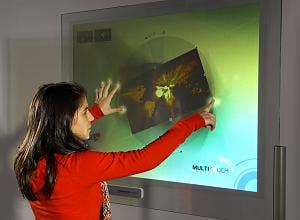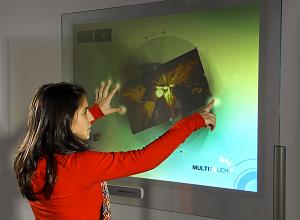Nanowire Polymer Film Turns Any Surface into a Multitouch Interface

Share
Portuguese engineers have taken us one step closer to fusing the digital and physical worlds. Displax, a fledgling tech company in Braga, has developed a device that can read the electrical disturbances in a thin transparent polymer film embedded with nanowires. Any pressure on the film (from a finger, or even from wind) can be detected and understood as a command. Apply the Displax Multitouch Technology (DMT) to any noncoductive surface and you've got an instant multitouch interface. According to their press kit, the DMT can interpret up to 16 fingers on a 50 inch screen. The film system can work on any surface from ~7 inches (18cm) to ~10 feet (3m). With drivers for Windows, Mac OS, and Linux, the DMT should be able to work with most conventional computers. Which means that all those non-touch LCD screens out there could be easily updated to be touch capable. With projectors every glass window, every wooden bench, every plastic surface could be used as an I/O device. The possibilities are awesome. Displax put its technology on display in several case studies. We have video of a concept store and a museum for you to enjoy below. Behold the power of film.
Touch surfaces are emerging as a dominant contender for the next human-computer interface. Many smart phones are now touch capable (more's the pity for my meaty fingertips) and the iPad is likely to popularize the same concept for tablet computers (though Apple isn't the first to merge those technologies). We've also seen touchscreens make impressive splashes in novel settings like the Ring Wall in Germany and the Hard Rock Cafe in Las Vegas. These things are practically everywhere. Now, with Displax, that may take on a literal truth. Most of the surfaces around us are nonconductive and less than 3m in size. The DMT could go on almost everything. What's the world going to be like when anything we touch could interpret our actions as commands?
The Displax Multitouch Technology has some impressive specs. It's completely transparent (to the naked eye), a 50 inch screen with processor weights just 300 grams, isn't affected by lighting conditions, and it's sensitive enough to detect you blowing on it. Curved surfaces are ok, and it works indoors and outdoors. 16 fingers on a single 50 inch surfaces is probably more than enough for most applications, but Displax is hoping to increase that limit later. The DMT will start shipping in July 2010 with prices to be announced later. It will come with a software package that includes applications for photos, videos, and Google Maps. All in all, it's a tidy little package.
Be Part of the Future
Sign up to receive top stories about groundbreaking technologies and visionary thinkers from SingularityHub.


But it's only half complete. Displax provides the touch interfaces, but they don't provide the display. Maybe that's a quibble, but it's going to affect how this technology is applied. Put the film on a screen and it becomes a touchscreen, with flashing icons and things to indicate your commands are being interpreted. The same holds true for a surface with an image projected onto it. However, for a non-screen surface there's just input, no output. That's ok for some applications (like turning your whole wall into simple controls for a radio), but what we really need is a thin transparent film that can also display images. Combined with the DMT a thin film display would turn any surface into a full-fledged touchscreen. Perhaps if the multitouch half of the concept works well, someone will develop the display half (we've already seen a few technologies that are headed in that direction).
Of course, we have no idea how well the concept will catch on until it actually hits the market. Certainly interactive window displays (as seen in the video) and wall controls are cool, but they may not find a customer base, especially if they are expensive. I wonder if LCD screen manufacturers will be willing to incorporate DMT into their existing models as a quick bootstrap way of turning every computer monitor into a touchscreen. That could be a really cool application that catches on very quickly.
I'm very curious about the embedded nanowires in the polymer film. Displax doesn't manufacture this film itself (it has a partner for that) just the processing unit. Could the same technology that turns pressure into electrical disturbances generate electrical current? Could nanowires in polymers serve as ultrathin computer circuits? There are likely to be many applications for this kind of technology outside of touchscreens.
For now, though, I'm just impressed with the wide range of places we might see these screens appear. It's too soon to know if they'll catch on, but they could turn every shop window into an interactive catalog for the goods inside. Your chair could know if you're sitting on it, and could play relaxing music if your seat-signature seems too tense. Any table top could become a keyboard, or a piano, or a drum kit. The possibilities are endless. It's likely to take years to develop the software for such applications, but the DMT hardware seems to be available now. If Displax, or some other cheap touchscreen technology, catches on, it will go a long ways towards "waking up" our physical world so that it looks for and responds to our input. I wonder what we'll tell it to do?
[image/video/source credit: Displax]
Related Articles

This Light-Powered AI Chip Is 100x Faster Than a Top Nvidia GPU

How Scientists Are Growing Computers From Human Brain Cells—and Why They Want to Keep Doing It

These Brain Implants Are Smaller Than Cells and Can Be Injected Into Veins
What we’re reading


